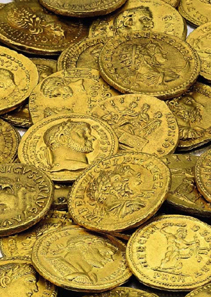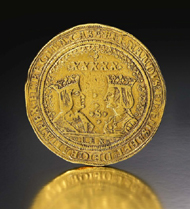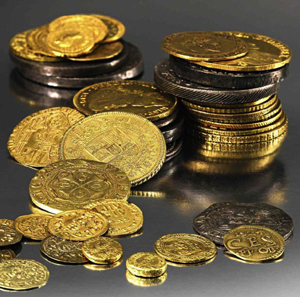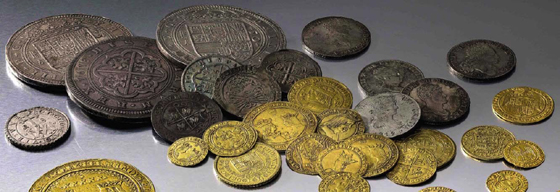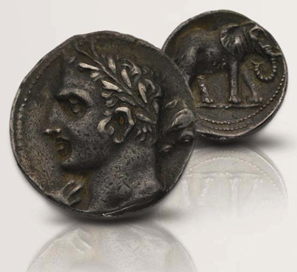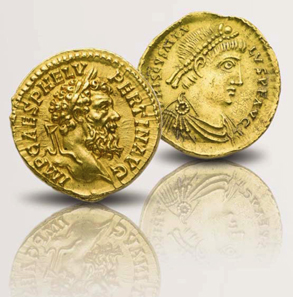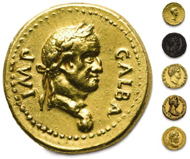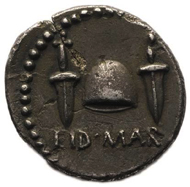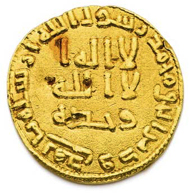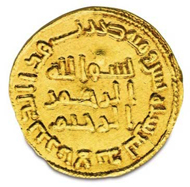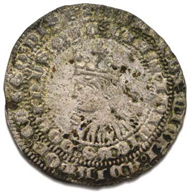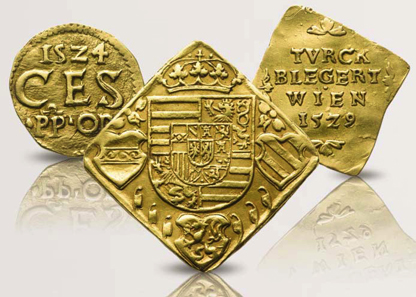January 12, 2012 – Sotheby’s announces that it will offer the magnificent Archer M. Huntington Collection of coins from the Hispanic world in a sealed bid auction ending on 8 March 2012. Assembled more than a century ago, the 37,895 pieces form the most spectacular collection of coins relating to the entirety of Spanish history that is housed outside of Spain.
The ambitious collection is among the finest and most comprehensive ever to be assembled, either by an individual or institution. The collection is being sold by the Hispanic Society of America (HSA) and proceeds will be used for future acquisitions and collection care. Through the sealed bid auction process, clients will be invited to place written bids on the collection as a whole. The collection is expected to realize between $25/35 million, and will be on public exhibition in its entirety at Sotheby’s York Avenue galleries during February 2012. In addition, highlights from across the collection will be on view from 3-6 January, as well as 9 January.
Fifty Excelentes struck under Ferdinand and Isabella.
Of the tens of thousands of coins in the Collection, the cabinet is highlighted by the monumental and unique example of the Fifty Excelentes struck under Ferdinand and Isabella. Created during the period of Christopher Columbus’s expeditions to the New World, the massive gold coin – weighing nearly five ounces – was likely minted as a special presentation to an individual whom the king and queen wished to honor. Huntington’s Fifty Excelentes is arguably the most important and valuable European coin in existence, and the largest gold coin from the 15th century that survives today.
“Archer M. Huntington’s collection represents something truly remarkable,” said David Redden, Vice Chairman of Sotheby’s and Head of the Special Projects department. “In a very real and tangible way, the nearly 38,000 coins provide a comprehensive view of world history – from the 5th century B.C. to the 20th century – with Spain as the primary focal point. The breadth of the material is simply astonishing. Mr. Huntington’s lifetime passion for the peoples, culture, and history of the Iberian Peninsula is represented in a collection not of sections, but of collections, each one of which could stand on its own as a world class cabinet of museum quality and consequence.”
Mr. Redden added, “It is also worth noting that Huntington’s collection quite simply could not be replicated today. And despite the fact that this is one of the most fully-published coin collections ever to be offered for sale, there are still discoveries yet to be made by the purchaser.”
Dr. Mitchell A. Codding, Executive Director of the Hispanic Society of America, commented, “The decision to sell The Huntington Collection followed an extensive review and valuation of the coins as well as an evaluation of their place within the HSA’s mission. As an art museum and research library we have never exhibited the coins nor retained expertise in the field. The proceeds from the sale will allow us to continue to grow our extensive collection of important Spanish and Latin American paintings, sculpture and decorative arts in keeping with our mission to promote the study and appreciation of the arts and literature of the Hispanic world.”
Dr. Codding continued, “While we are placing no restrictions or requirements on the buyer, we value Archer Huntington’s achievement so highly that we have instructed Sotheby’s to sell this collection as a single lot. Sotheby’s had earlier explored placing the collection with public institutions in Spain, Europe and the United States, and we will continue to do so.”
Archer M. Huntington & The Hispanic Society of America
Born in 1870, Archer M. Huntington grew up to become one of the wealthiest and most generous benefactors in America. His mother and stepfather encouraged travel as part of Archer’s education, and while still a teenager his interests became increasingly focused on Spain and its global influence.
Huntington visited the Iberian Peninsula on his own, collecting books, manuscripts, coins, paintings, sculpture, and artifacts, and even participated in archaeological digs. He made it his intention to assemble coins from every period and in every land where Spanish influence was felt, however remotely. Completed by 1905, the resulting collection is encyclopedic in content and filled with stunning rarities.
Among the many institutions that Archer Huntington sponsored, he founded The Hispanic Society of America (HSA) in 1904 as a free museum and research library for the study of the arts and cultures of Spain, Portugal, and Latin America, which it remains today. He gave land at Audubon Terrace, in the present day Washington Heights neighborhood of New York City, and funded the design and construction of a building by his cousin Charles Pratt Huntington. In 1949, Archer transferred ownership of his collection to the Board of Trustees of the HSA, but his collection never was accessioned as part of the HSA collection.
The following pages present the contents and highlights of the Huntington Collection, divided into the historical periods that it encompasses.
Ancient Spain
Prior to Hannibal’s defeat by Rome in the third century B.C., the Iberian Peninsula was inhabited by a number of cultures, including the aboriginal Iberians, Celts, Phoenicians, Greek traders and Carthaginians. Huntington’s collection of coins relating to this period is remarkably comprehensive, and has been ranked as equal to those in the world’s most important national collections in London (the British Museum), Paris (the Bibliothèque Nationale) and, most impressively the Museo Arqueológico Nacional in Madrid.
There are a number of great rarities contained in this section, including the Carthaginian 1 1/2 Shekel, which bears the head of the god Melkaart on one side – whose features may represent those of Hannibal himself – and an African elephant on the reverse (pictured right).
Rome: From Republic through Empire
The ascendancy of the Romans on the Iberian Peninsula from the second century B.C. effectively created the concept of a unified Spain. During more than six centuries, the two provinces of Spain became an increasingly important asset, providing great wealth and resources for the Empire. Although Huntington’s focus was on Spain, he used Rome’s rule of the region as rationale to expand his collection to include not only pieces struck on the Iberian Peninsula, but also Roman coins which may have circulated there as well.
The more than 400 Roman gold coins are particularly impressive and span the full history of Rome. The collection includes examples struck under Julius Caesar, Brutus and Cassius, Sextus Pompey, the twelve Caesars, the Spanish-born emperors Trajan and Hadrian, as well as multiple examples of short-lived emperors such as Galba, Otho, Vitellius, Pertinax and Macrinus. The gold solidus, which was struck during the momentary reign of Priscus Attalus (A.D. 409-410), is one of only twelve known examples, highlighting the impressive nature of the collection.
An additional 3,000 silver and bronze coins from the earliest days of the Republic through to the collapse of Rome attest to the depth of this section, which includes an example of what is probably the most famous coin of antiquity:
… the Ides of March denarius, struck by Brutus to commemorate the assassination of Julius Caesar in 44 B.C., only months after Caesar’s return from Spain and the battle of Munda.
Visigothic
With the fracturing of the Roman Empire came the onslaught of Germanic tribes, and the Visigoths, who sacked Rome in 410, were among the most successful. From the mid-5th century they were the dominant power in Spain, until the extinction of the kingdom by Muslim invaders beginning in 711.
Huntington’s collection of Visigothic coins stands as the single greatest holding of this fascinating and important series ever formed. No individual or institution can claim even remotely comparable holdings. The Visigoth’s coinage began – as did other Germanic tribes – with coin types that were imitative of the then-circulating Roman coins. In the late sixth century, King Leovigild added his name to the coinage, and the design types evolved into the first mediaeval coinage with a distinct national character, as well as an almost proto-Picasso aesthetic.
Islamic Spain
In 711, a force of about 7,000 Muslim troops first entered Spain under the command of Tariq at the Straits of Gibraltar. In a chaotic engagement, the Visigothic forces – then under King Roderic – were annihilated, and a new chapter of history on the Iberian Peninsula began.
Because they tend not to include imagery, giving more space for written detail about their production, Islamic coins are recognized as some of the most historically revealing ever struck. Huntington’s collection in this period is of singular importance not only for the breadth and variety of the dynasties it spans, but also because of the sheer mass of material, brilliantly illuminating the economic and artistic prosperity of Muslim rule through seven centuries.
Most notably, the Islamic collection includes examples of all three denominations of the first gold issue of coins of purely Islamic design to be struck in Spain (102h/A.D. 720). The Huntington Collection is likely the only institutional collection in the world to contain examples of all three.
Medieval & Modern Spain
In the 11th century, as the Umayyad dynasty collapsed in Spain, the Christian kingdoms and counties gradually consolidated power and began their expansion. In 1492, the united crowns of Ferdinand V and Isabella completed the unification of Spain with the conquest of Granada, and the country stood at the threshold of its golden age.
Archer Huntington’s collection of coins from the mediaeval and later period has been called one of the greatest in existence, documenting the reassertion of the Christian kingdoms through series of coins that are both humble and grand. In addition to the Fifty Excelentes, as well as its smaller cousin the Ten Excelentes (one of only two examples known), this subcollection contains an array of celebrated rarities.
The astonishing Reale (Blanca) of Beatriz of Portugal, who married King Juan I of Aragon in 1383, depicts the first woman on Spanish or Portuguese coinage. And despite having been published for more than a century, the whereabouts of a unique Eight Escudo piece struck in Pamplona in 1652 was unknown until discovered by Sotheby’s experts in the Huntington Collection.
Imperial Spain
The joining of the crowns of Spain, the vast riches recovered from the Age of Discovery, and the election of King Charles I of Spain as the Holy Roman Emperor Charles V in 1519 set the dynamics for the extraordinarily swift spread of Spanish influence around the globe.
Spain’s cultural and political power spread through Europe and the New World, and Huntington expanded his collection to include territories that fell under Hapsburg or Portuguese rule. An astonishing array of thousands of coins in Huntington’s collection fully chronicle this extraordinary period in Spanish history, evincing both the vast wealth discovered in the New World as well as the battles on virtually all fronts that simultaneously drained resources. Regular issue coins from Italy, France, Germany and the Low Countries underscore Spain’s expansion throughout the European continent, while a remarkable collection of jetons – small medals – record Spain’s losing 80-year civil war in the Netherlands.
One of the most fascinating and important sub-collections is devoted to emergency issues struck in time of need, often to pay troops under siege. Often crudely produced, these coins are by their very nature not only rare, but important historical snapshots of both minor engagements and some of history’s most significant events.
Within the impressive collection of Colonial issues are examples of the first coins made for use in the New World, as well as coins from the first mint in the Americas at Mexico City. More than a dozen Royal presentation strikes, which are some of the most desired coins from this period, are highlighted by an important and possibly unique gold Eight Escudo piece that was struck in Mexico City in 1729.
The Hispanic Society of America (HSA)
The Hispanic Society of America was founded in 1904 by Archer Milton Huntington (1870-1955) with the object of establishing a free public museum and reference library for the study of the art and culture of the Iberian Peninsula and Latin America. The collections of the Hispanic Society are unparalleled in their scope and quality outside the Iberian Peninsula, addressing nearly every aspect of culture in Spain, as well as a large part of Portugal and Latin America. With more than 800 paintings and 7,000 watercolors and drawings, the Hispanic Society offers a comprehensive survey of Spanish painting and drawing, including masterworks by El Greco, Velázquez, Goya, and Sorolla. Similarly, the collection of almost 1,000 works of sculpture contains outstanding pieces from the first millennium B.C. to the early 20th century.
Magnificent examples of ceramics, glass, furniture, textiles, ironwork, and jewelry abound among the more than 6,000 objects in the Society’s varied collections of decorative arts. Among the works on paper, 7,000 drawings and 15,000 prints afford a unique view into the graphic arts in Spain and Latin America from the 17th to the early-20th century. More than 175,000 photographs from 1850 onwards document the art, culture and customs of Spain and Latin America. The Library offers unrivaled resources for researchers interested in the history and culture of Spain, Portugal and their colonies, with more than 250,000 books and periodicals, including 15,000 volumes printed before 1701, along with over 300,000 manuscripts, letters, and documents dating from the tenth century to the present.
If you want to learn more about the Hispanic Society of America, click here.
If you want to know more about the collection, click here.





